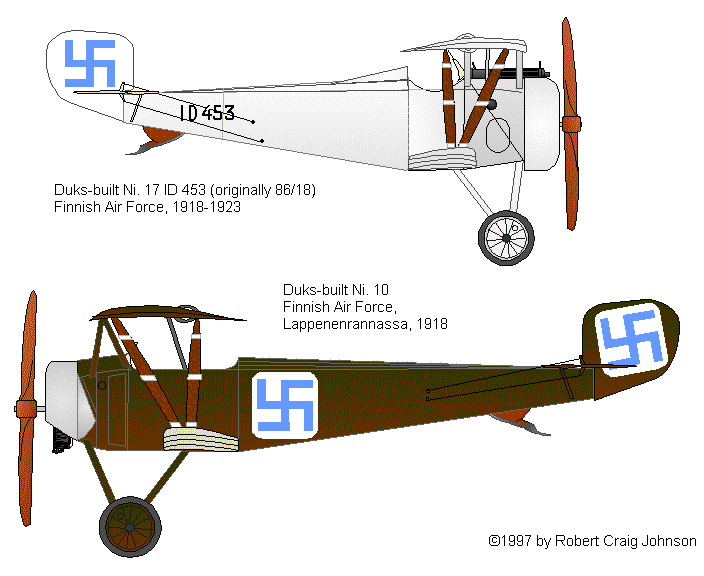
The collapse of the Russian Empire in 1917 and the near simultaneous collapses of the Prussian and Austrian Empires in 1918 produced a sudden outpouring of nationalist sentiment among nations and peoples that had lived more or less peacefully (if not always happily) under foreign rule for a century or more. One product of this great, war's-end movement was, as we have seen, Poland. But Poland was not alone. Bolshevism, remnants of the Junkers—the old Prusso-Baltic nobility—and Germany's terroristic freikorps threatened smaller, less internationally recognized, less thoroughly militarized states even more than they threatened Poland. To the myriad smaller nationalities that had once been part of the great, multiethnic empires, moreover, Poland was at least as great a threat as Prussian militarism or Russian Bolshevism. The imperial systems of Central and Eastern Europe had often favored minorities. At the very least, they had kept more numerous (and thus more politically unreliable) ethnic rivals from gaining any overwhelming dominance in public life. Now, those restraints were gone, and no equivalent, Western European restraints, such as the embryonic League of Nations, were yet in place. The Poles were, moreover, after rather more than independence and self-determination. They wanted an empire of their own, with all territories that had ever been ruled by Poland, including Lithuania and the Ukraine, again under Polish control. The Poles seemed bent on restoring all the old inequalities but, this time, with themselves the main beneficiaries.
Like the Poles, Latvians and Czechs had had their own Legions in the Russian and, in the case of the Czechs, the Austrian armies. Czechs had also served with the French in the West. Estonians, Finns, Lithuanians, and Cossacks held prominent positions in the Imperial Russian forces, while Cossacks, Finns, and Ukrainians served the Germans and/or Austrians. As the Russian, Austrian, and German armies came apart in the last days of World War 1, these small, ethnically based units often emerged as the only coherent, disciplined military forces operating in vast stretches of suddenly lawless and rebellious territory. A few Latvian battalions secured Lenin's position in the crucial, coup-wracked days of 1918. The 60,000-man Russian Czech Legion was able to fight its way across Asia and Russia to Vladivostok and back in hijacked, hastily armored trains. Count von Mannerheim used Finnish veterans of the German and Czarist forces to crush less well-organized, less well-equipped Red Finns in a bitter civil war, while harassing the flanks of the Allied intervention force at Archangel.
These forces provided the backbone of the armed services of the new nations of the Baltic and Central Europe as well as the principal striking force of the remnants of the White Russian armies. They crushed Bolshevist or, as in Hungary, supported Bolshevist uprisings in their own countries and waged war against the nationalist movements in neighboring states. Thus, Czechoslovakia fought a short but sharp war of aggression against Red Hungary while defending itself from White Poland's neo-imperialist attacks. Poland invaded Lithuania and seized the capital, Vilnius, renaming it as the Polish city of Vilna. Latvia battled German freikorps, resurgent Junkers militias, and as-yet undemobilized Prussian regulars. Estonia resisted the Germans, the Bolsheviks, and Iudenich's notoriously brutal but militarily ineffectual White Russians. As we shall see, Britain aided the Balts where she could, using naval forces, including aircraft carriers, submarines, destroyers, and Coastal Motor Boats, the MTBs of WW1. In the south, Deniken's Whites fought the local Russians and Ukrainians, the Bolsheviks, and various bandits with the aid of clandestine British and French units, mercenaries, Germans, and the now nominally independent Don Cossacks.
All of these groups had air forces of one sort or another. Most relied on captured Austrian and Czarist equipment, notably Dux-built Nieuports, Voisins, Oeffag-Albatros fighters, and Hans-Brandenburg two seaters. The Finns and Balts used German aircraft as well. The Balts, Czechs, and White Russians received aircraft, munitions, pilots, and training from the French, British, and Italian governments. Archangel and the Black Sea and Pacific ports were all in allied hands.
Finland's air force was shaped by strong German influence and by an aggressive anti-bolshevism born in the bloody civil war that followed independence. Finland's parliament declared independence of Russia in December 1917, and fighting broke almost immediately. The Finnish Communists favored a continued, close relationship with Moscow, much like the old Imperial system, only with socialists at the helm. The Whites identified with Prussia and with Finland's old Swedish aristocracy. Finland was the established port of entry linking Russia and Germany (Lenin took this route when the Germans returned him to Russia in 1917). By raising the spectre of a Red Terror among conservative Finns, the military government in Berlin no doubt hoped to shut the door between the Soviet masses and their own, restive, increasingly radicalized proletariat.
Be that as it may, fighting broke out almost immediately in 1917. The Finnish Red Guard had the aid of some 40,000 irregulars from Soviet Russia, though, given the composition of the pre-1917 Russian army, many of these might have been ethnic Finns themselves. The White Guard depended heavily on German regulars, who served in large numbers in Finland, and on German arms and supplies. The capable generalissimo of the White faction, Marshall von Mannerheim, soon crushed the Reds in a brutal, bloody campaign that left a lasting undercurrent of political extremism in Finland for many years after. The Communist Party was proscribed, and Mannerheim and his military cronies ruled by decree for a few years. Prompted by their German allies, Finnish saboteurs and snipers made themselves a major annoyance along the flanks of the Allied intervention in north Russia. Happily, the German military collapse at home and on the Western Front cut short this unwholesome union. The Inter-Allied Control Commission forced Germany to withdraw its forces from Finland and left the Finns to settle their own affairs, through land reform and a return to liberal, democratic government.
Finland's official first aircraft, a Swedish Thulin-built Morane parasol, was the gift of a private citizen and foreigner, Swedish Count Eric von Rosen, who flew into the country with his pilot shortly after independence (a German Albatros B.II may, in fact, have arrived earlier, but this makes a less attractive story). The Count's personal lucky charm was a blue swastika, which the Finns quixotically adopted. It must be said, however, that swastikas were common emblems on the White side at the time. Latvia and various German freikorps units used it (the latter, in fact, inspired the Nazis to adopt the symbol). It may thus have had some significance at the time that has since been forgotten. This insignia became the Finnish national marking until 1944, when Finland turned against Germany.

In Finland, as elsewhere in the east, distances were great and airplanes few. Types that, like the Thulin, were obsolete elsewhere still had a useful military function. Initially, the service's combat capability rested on a mixture of captured Russian Nieuports, At least one SPAD VII, old trainers, and German and Russian seaplanes. As Germany began to take a more active interest in the civil war, new equipment followed, including DFW C.V two-seaters, Rumpler 6B fighter seaplanes, and a few Fokker D.VII fighters. In 1923, one of the Fokkers was used for an interesting experiment with painted, splinter camouflage.
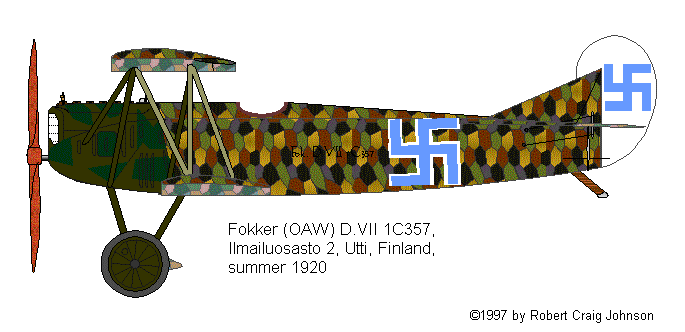
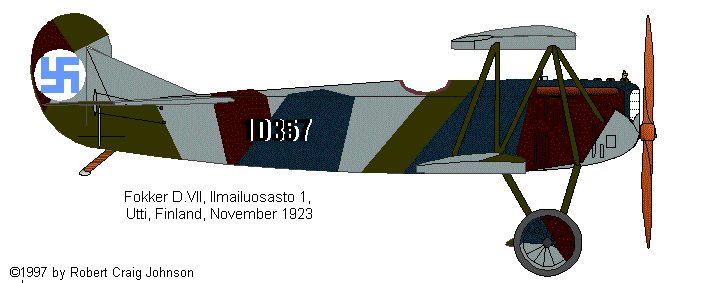
Estonia's experience typified the less internalized, localized kind of fighting that took place on the southern shores of the Baltic. Here, divisions were not as clearcut. The White forces—German regulars, ethnic German Baltic militias, freikorps troops, indigenous nationalists, Poles, White Russians, and the Allies—frequently worked at cross purposes or fought one another openly. When Estonia declared her independence on 24 February 1918, she faced near simultaneous attacks from Bolsheviks in the east the Germans in the south. By 1918, Germany's still intransigent militarists hoped to escape the worst effects of the impending disaster on the Western front by expanding to the East, particularly in the Ukraine and the Baltic. The German army thus refused to recognize Estonia's sovereign status. When treaty negotiations with the Bolsheviks stalled, German troops seized Latvia and southern Estonia, disarming and disbanding local military units as they went. Germany's defeat in November 1918 brought no peace to the embattled Balts. While the Germans made a show of pulling back, the Red Army overran the country. Finnish, British, and French aid helped the Estonians drive the Bolsheviks from Estonian and much of neighboring Latvia by 1919. But then the Germans returned, under the colors of the Baltische Landeswehr, a militia serving the interests of the region's ethnically German nobility, the Junkers. The Landswehr moved north from southern Latvia, supported by Germany's Iron Division and freikorps units. A short, sharp war ended with an Estonian victory at the Battle of Cesis, 22-23 June 1919. Operations then resumed against the Reds and against Iudenich's Whites, who were finally disarmed and interned after their disastrous November 1919 attack on St. Petersburg. Estonia and Soviet Russia signed a peace treaty in February 1920.
The Estonian Aviation Company came into being on Armistice Day, 1918. At first, aircraft were all captured or scrounged from the former Imperial powers. The service's first equipment comprised three Grigorivich M9 flying boats brought by defecting Red pilots. A Soviet Farman (HF30) was captured near Narva, repaired, and flown on the service's first bombing and reconnaissance missions until the fuel and oil ran out. It was then dismantled and shipped to the rear. Later, a Sopwith Strutter was found abandoned in Tartu.
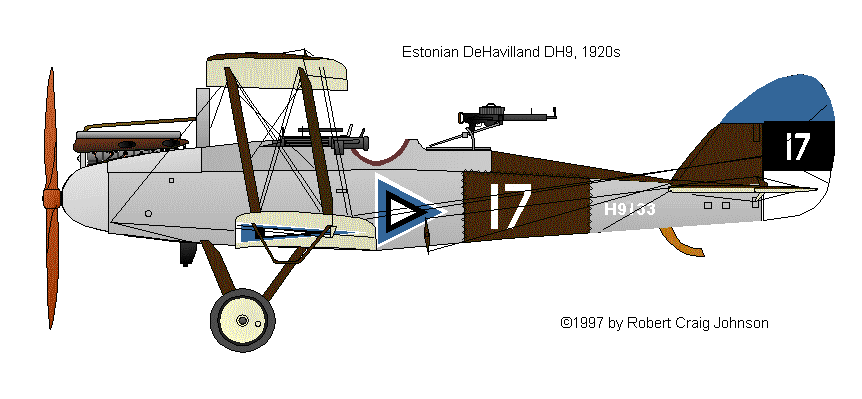
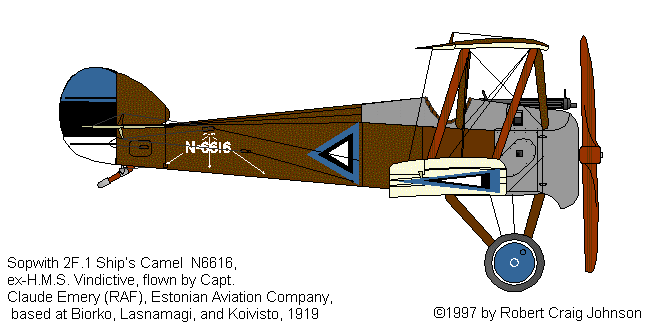
The British now agreed to supply the Estonians with arms and aviation equipment. A pair of BE.2s and a pair of Norman-Thompson NT2B flying boats were first to arrive. Then came AVRO 504Ks, DH.9s, and Short 184 seaplanes, all well-worn. Capt. Claude Emery was detached from the RAF at the same time to serve as an advisor and Chief Instructor. When the carrier HMS Vindictive arrived in the Baltic in July 1919, it landed one of its 2F1 Camels for Emery's use.
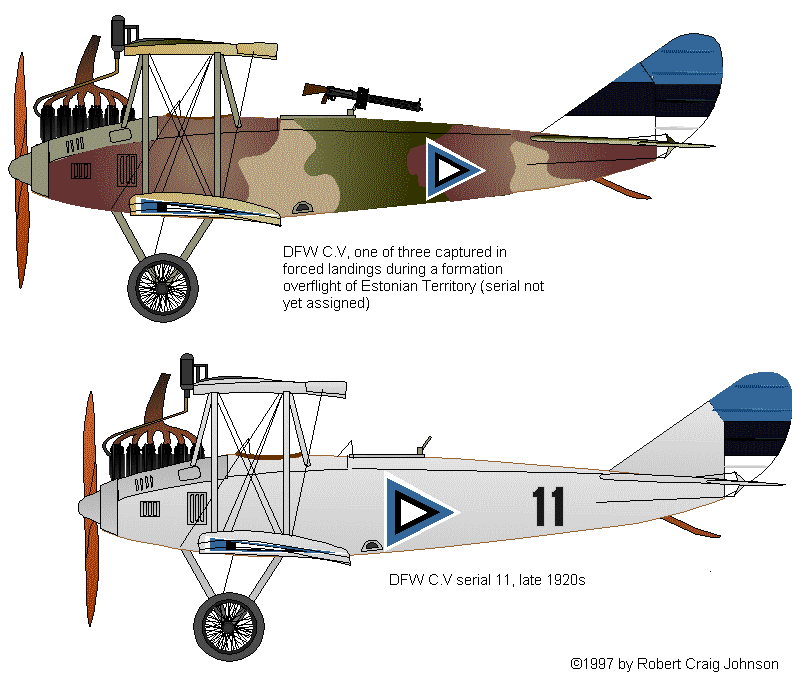
The Landswehr putsch brought the Aviation Company its next airplanes. Three German courier aircraft—two DFW C.Vs and a Halberstadt C.V—made forced landings in Estonian territory while attempting to carry despatches to Iudenich at Narva. The Germans were trying to interest the White Russian general in coordinated action against the Bolsheviks and, in all likelihood, the Estonians. The captured couriers escaped with the aid of a mercenary pilot, but their airplanes were pressed into Estonian service. Two more DFWs and an AGO C.V were captured from the Landswehr later. One Estonian DH.9 was shot down by a friendly armored train during this campaign.
As we noted in our earlier piece on Poland, the nature of the fighting was such that reconnaissance became the primary function of aviation in these conflicts. Good intelligence was at a premium during confused flanking actions in open country and in mad dashes along rail lines. Most of the two-seaters thus served as aerial scouts or cavalry. Supply shortages were the main limit on aerial action. The Estonian Aviation Company managed some two-dozen sorties during the whole of the fighting, all but two with non-Estonian pilots.
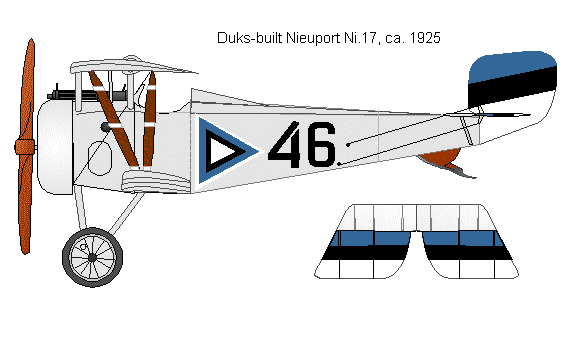
The service held a total of 28 aircraft at the conclusion of hostilities, including Nieuports and RE.8s taken from the White Russians. One Halberstadt C.V was converted to a reportedly rather unsatisfactory seaplane. Other Halberstadts (4 Cl.IVs and 4 C.Vs) were obtained from a collection of German aircraft at Vamrup in Denmark and given serial numbers 58-65. A Friedrichshafen FF.41 seaplane abandoned without engines by the Germans was successfully re-engined, but was soon lost in an accident.
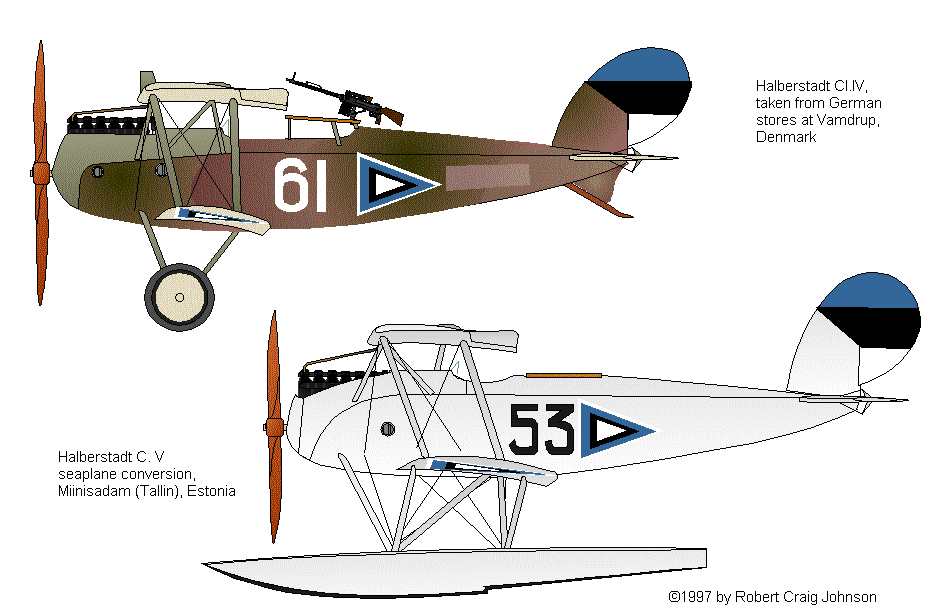
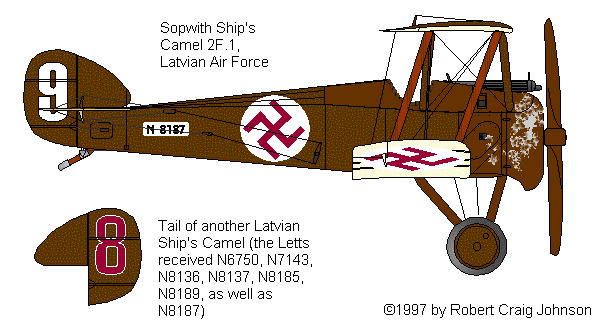
Latvia's air service was likewise the product of British largesse. HMS Vindictive handed over at least seven of her Sopwith 2F.1 Ship's Camels to Latvia, including N6750, N7143, N8136-37, N8185, N8187, and N8189. The Latvians also operated some Sopwith Strutters. These may have been captured from the Reds, supplied by France, or ship's Strutters contributed by the Royal Navy. Some Ansaldo A.1 Ballilas were obtained too.
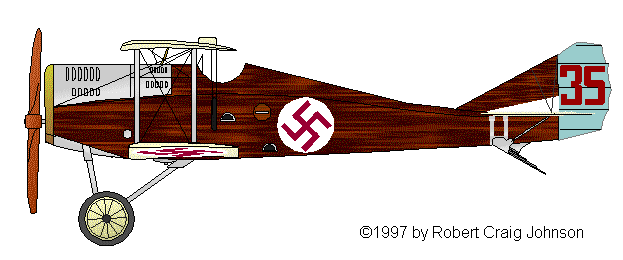
The last Baltic state, Lithuania, suffered from her proximity to the Soviets, the Poles, and the Germans. Lithuania's armed forces cooperated closely with the Germans in 1917-18. German troops helped repel the first Soviet invasion of the country in February 1918. But the German withdrawal in November provoked a new Bolshevik offensive. The Reds were successful. In January 1919, they captured Vilnius, the Lithuanian capital. Just days before this signal defeat, the Aviation Company of the Lithuanian army engineers formed around one captured Bolshevik Sopwith Strutter. By April, Germany had supplied Albatros B.II trainers, eight LVG C.VI two-seaters, and a number of mercenary pilots and mechanics. An all-metal Junkers F.13 transport was seized while on its way to the USSR. Junkers offered Fokker D.VII fighters in exchange for their aircraft, but the offer was nullified by the Allied Control Commission. This body forced the German mercenaries and instructors to return home. Lithuania now turned to Britain for contract pilots and ground crew. These managed to train 35 Lithuanian pilots before leaving the country at year's end.
Like Latvia and Estonia, Lithuania faced partial occupation by Germany's aggressive Baltische Landswehr well after the official German withdrawal. But here, Allied vigilance spared the country much of the trouble its neighbors suffered from this cause. The Allied Control Commission forced Germany to remove her paramilitary units as well as her regulars. It also forced the Germans to abandon substantial aircraft stocks intact in Lithuania. This windfall gave the Lithuanian Aviation Company a number of Albatros trainers and C-type two seaters, Halberstadt Cl.IIs, Cl.IVs, and C.Vs, LVG C.Vs and C.VIs, DFW C.Vs, and Fokker D.VIIs. Some 35 airplanes were available by Spring 1920.
These were needed. While the Treaty of Moscow settled the border dispute between Lithuania and the Soviet Union during the summer of 1920, it did not bring peace. Bolshevik occupation of Vilnius had brought Poland into the war. Since Vilnius was technically still part of Russia, according to the Versailles treaty the Treaty of Moscow had decided the city's legal status. But Poland disputed the Lithuanian claim. She demanded all formerly Polish territory and all areas that held significant Polish minorities. The League of Nations reluctantly started work on a mediated settlement, but the aggressively nationalistic Poles were not enthusiastic about compromising with a weaker, historically subject neighbor. They little reason to entrust their affairs to an international organization that had, in their eyes, already deprived them of the full measure of their God-given rights in Silesia, Galicia, and the Ukraine. So, when the Bolsheviks entered Vilnius in April, Poland seized on "Red aggression" as a pretext to occupy the city. This ill thought-out action precipitated the Russo-Polish War.
In the wake of Gen. Tukhachevsky's famous Red counter-offensive, the Russians honored their treaty with Lithuania, and allowed her forces to reoccupy their city. But when the Red offensive collapsed, Poland turned her whole force against Lithuania. Now throwing all pretexts out the window, Pilsudski mounted a full-scale invasion. Lithuania's aviation company flew extensive reconnaissance sorties, as well as a few bombing missions against armored trains and ground troops. Lithuanian resistance proved much greater than expected. In October, Poland felt forced to sign a treaty recognizing Lithuania's sovereignty over Vilnius. To the surprise of the Lithuanians, she did not, however, feel forced to actually honor the treaty. Two days after the signing, Polish forces launched a lightning offensive and seized the city. They grabbed almost a third of Lithuania's remaining territory as well. The Lithuanians were by now too exhausted to keep fighting, however. So Poland kept her ill-gotten gains and both parties settled into an uneasy, de facto peace. The Allies chose to recognize Polish fait accompli in 1923, and the Lithuanians consoled themselves by forcibly seizing the Baltic port of Memel, a formerly German city under League of Nations administration.
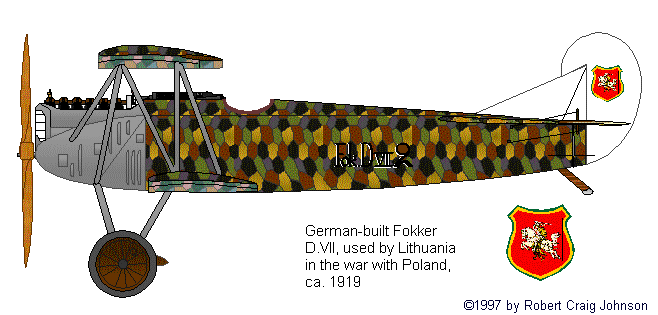
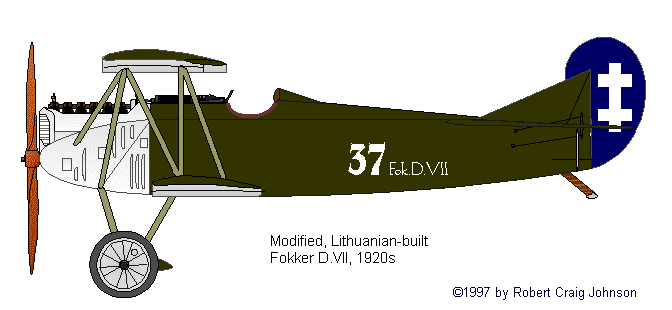
The new central-European state of Czechoslovakia, surrounded as she was on all sides by potentially hostile neighbors, also had immediate need of an air force. Poland had ambitions on the Teschen region, a one-time Austrian duchy with large coal reserves, heavy industry, an important stretch of railroad. Teschen straddled the Polish-Czech border and had a mixed Czech and Polish populace. In 1919, disputes and skirmishes nearly erupted in full-scale war. The Czechs were far more militarized than the Lithuanians, however, and the Poles were in the opening stages of their war with Bolshevik Russia. So great-power mediation was more successful. Poland received the city of Teschen itself, while Czechoslovakia received everything else, including the coal fields and the railroad. To the south, Czechoslovakia faced a turbulent and, in its own eyes, undefeated Hungary. To contain this threat, Czechoslovakia organized an alliance with Yugoslavia and Rumania, called the Little Entente. Entente members intervened in Hungary twice during this period. In 1919, the Rumanians invaded to overthrow Béla Kun's short-lived Communist dictatorship. The Czechs supported the operation. Then, in 1921, the exiled Habsburg monarch, Charles IV, tried to reclaim the throne from Admiral Horthy's rightwing regency. At its formation, the Little Entente had warned Hungary that it would consider restoration a casus belli. The Czechs began to mobilize, but Admiral Horthy defused the situation by arresting Charles and handing him over to the Allies.
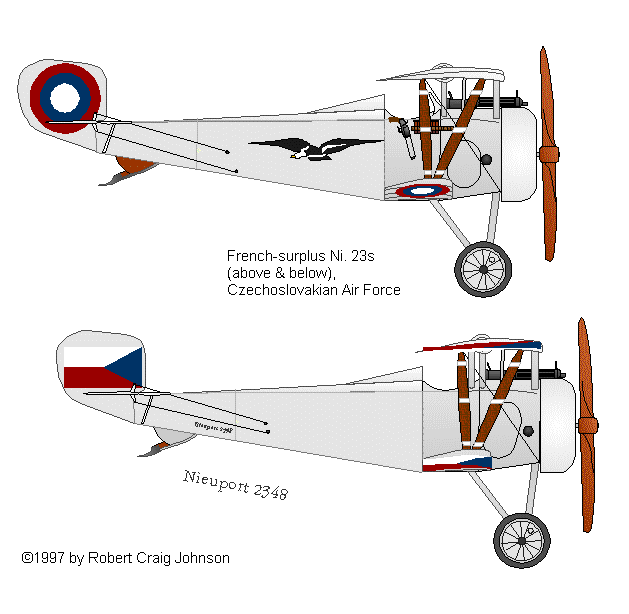
The Czech air force was at first a hodgepodge of Russian and Austro-Hungarian materiel, mostly assorted Nieuports, Oeffag-Albatros fighters, Brandenburg C types, and Anasal two-seaters. The invasion of Red Hungary brought the service a number of MAG-built, Austro-Daimler powered Fokker D.VIIs, and the French supplied SPAD XIIIs and Breguet XIV bombers in some numbers. These tided the Czechs over until the 'Twenties, when their own aviation industry took over the task of supplying the air force.
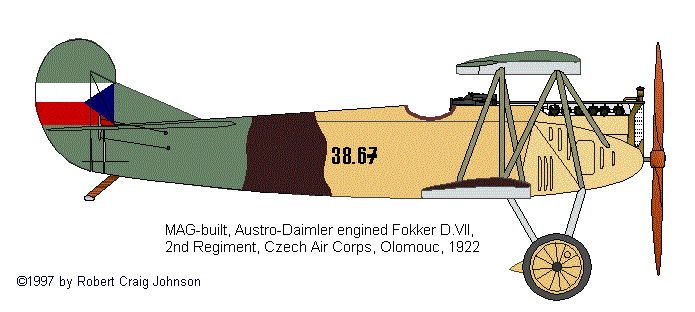
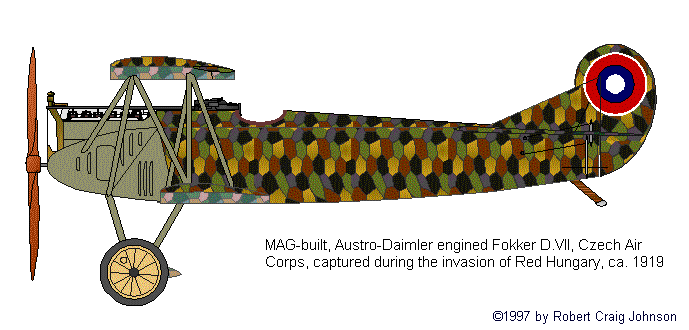
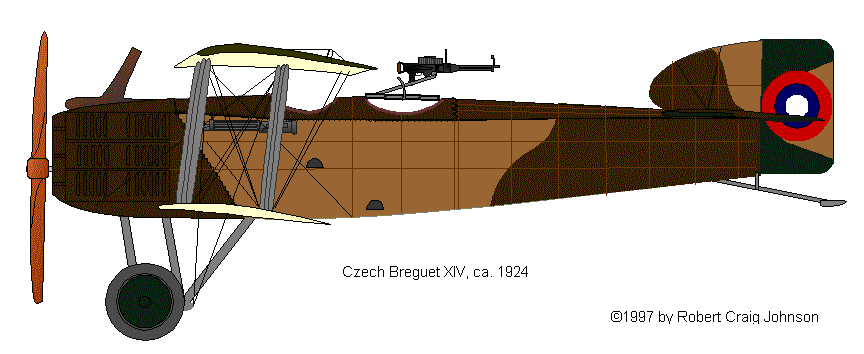
The White Russians also had their own air forces, though often as not these were little more than front organizations for the Western Allies themselves. In the south, Gen. Denikin's forces had, in addition to the usual mix of Nieuport and SPAD scouts, two units mounted on reasonably state of the art British equipment. Curiously, the Russian-manned two-seater squadron's DH.9s carried normal RAF insignia, while the Sopwith F.1 Camels of the all-British South Russia Instructional Mission wore Denikin's markings. The instructional mission was actually a semi-clandestine combat unit, operating without official British government sanction from Ekaterinodar in 1919. When White resistance collapsed, the surviving Camels and DH.9s were lined up on the wharf at Novorosiysk and, under cover of the guns of French and British cruisers, crushed by a tank which was then driven off the end of the dock.
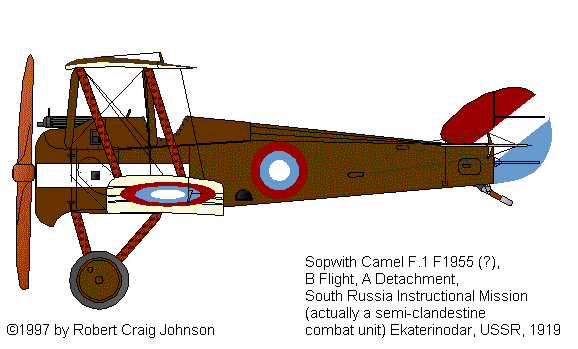
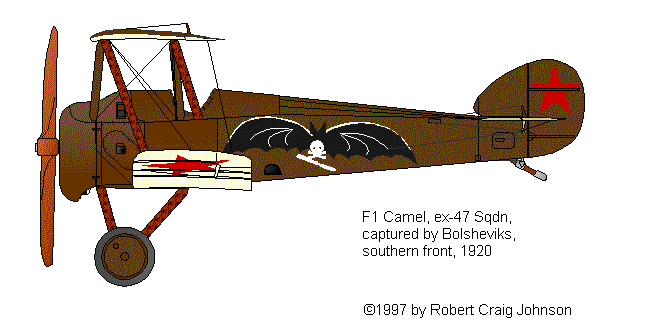
© 1997 by Robert Craig Johnson.